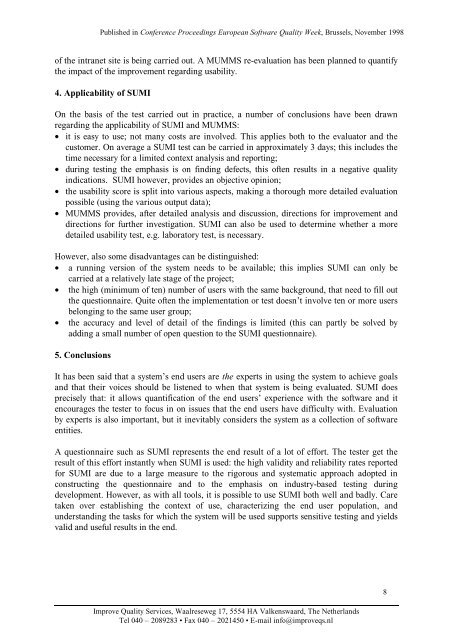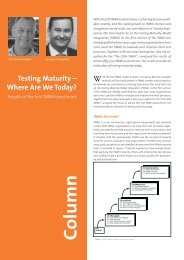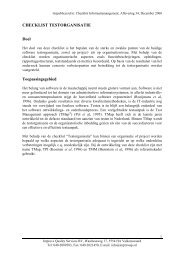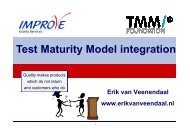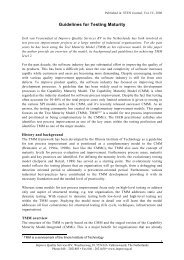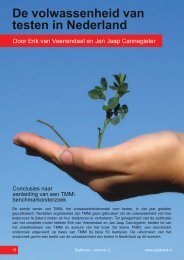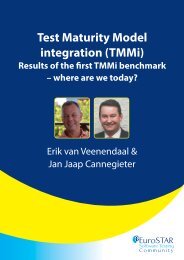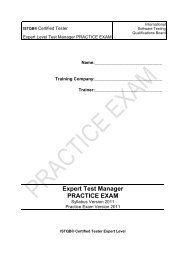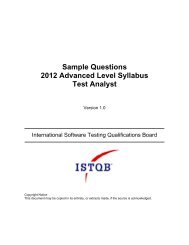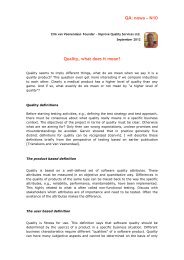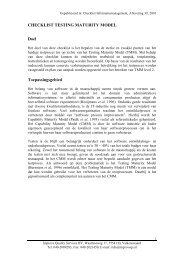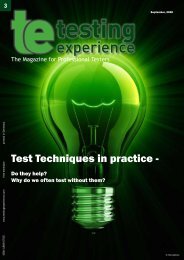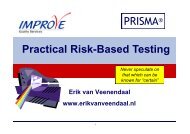Questionnaire based usability testing - Erik van Veenendaal
Questionnaire based usability testing - Erik van Veenendaal
Questionnaire based usability testing - Erik van Veenendaal
Create successful ePaper yourself
Turn your PDF publications into a flip-book with our unique Google optimized e-Paper software.
Published in Conference Proceedings European Software Quality Week, Brussels, November 1998of the intranet site is being carried out. A MUMMS re-evaluation has been planned to quantifythe impact of the improvement regarding <strong>usability</strong>.4. Applicability of SUMIOn the basis of the test carried out in practice, a number of conclusions have been drawnregarding the applicability of SUMI and MUMMS:• it is easy to use; not many costs are involved. This applies both to the evaluator and thecustomer. On average a SUMI test can be carried in approximately 3 days; this includes thetime necessary for a limited context analysis and reporting;• during <strong>testing</strong> the emphasis is on finding defects, this often results in a negative qualityindications. SUMI however, provides an objective opinion;• the <strong>usability</strong> score is split into various aspects, making a thorough more detailed evaluationpossible (using the various output data);• MUMMS provides, after detailed analysis and discussion, directions for improvement anddirections for further investigation. SUMI can also be used to determine whether a moredetailed <strong>usability</strong> test, e.g. laboratory test, is necessary.However, also some disad<strong>van</strong>tages can be distinguished:• a running version of the system needs to be available; this implies SUMI can only becarried at a relatively late stage of the project;• the high (minimum of ten) number of users with the same background, that need to fill outthe questionnaire. Quite often the implementation or test doesn’t involve ten or more usersbelonging to the same user group;• the accuracy and level of detail of the findings is limited (this can partly be solved byadding a small number of open question to the SUMI questionnaire).5. ConclusionsIt has been said that a system’s end users are the experts in using the system to achieve goalsand that their voices should be listened to when that system is being evaluated. SUMI doesprecisely that: it allows quantification of the end users’ experience with the software and itencourages the tester to focus in on issues that the end users have difficulty with. Evaluationby experts is also important, but it inevitably considers the system as a collection of softwareentities.A questionnaire such as SUMI represents the end result of a lot of effort. The tester get theresult of this effort instantly when SUMI is used: the high validity and reliability rates reportedfor SUMI are due to a large measure to the rigorous and systematic approach adopted inconstructing the questionnaire and to the emphasis on industry-<strong>based</strong> <strong>testing</strong> duringdevelopment. However, as with all tools, it is possible to use SUMI both well and badly. Caretaken over establishing the context of use, characterizing the end user population, andunderstanding the tasks for which the system will be used supports sensitive <strong>testing</strong> and yieldsvalid and useful results in the end.Improve Quality Services, Waalreseweg 17, 5554 HA Valkenswaard, The NetherlandsTel 040 – 2089283 • Fax 040 – 2021450 • E-mail info@improveqs.nl8


